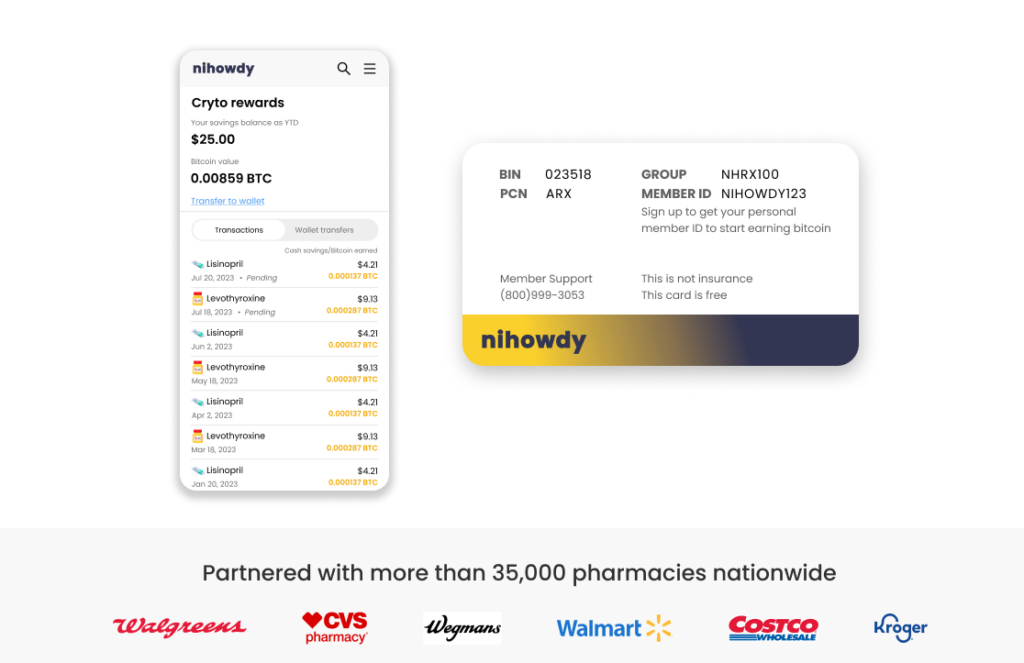Is Oxycodone Stronger Than Hydrocodone? Unveiling Pain Reliever Potency

If you’ve ever wondered ‘is oxycodone stronger than hydrocodone,’ you should know that oxycodone does exhibit greater potency. This key factor can influence dosage decisions and the management of side effects. In the following sections, we will compare these opioids in depth regarding their effectiveness and the considerations behind choosing one over the other for pain relief.
Key Takeaways
Oxycodone is generally considered stronger and carries a higher risk of overdose than hydrocodone, though they’re similar in pain relief effectiveness when prescribed correctly.
Side effects and the risk of addiction vary with each drug; oxycodone is particularly known for causing constipation and carries a higher addiction risk compared to hydrocodone.
Financially, NiHowdy’s Prescription Discount Card can ease the burden of medication costs with up to 85% savings and additional benefits like Bitcoin rewards.
Analyzing the Strength: Oxycodone vs Hydrocodone

Both hydrocodone and oxycodone are prominent options for alleviating moderate to severe pain in the realm of pharmaceuticals. Oxycodone. Is often considered more potent than hydrocodone, leading to more intense effects and a correspondingly increased risk of overdose due to its greater strength.
Yet when comparing hydrocodone versus oxycodone, potency isn’t the sole factor worth considering. The efficacy of these two drugs can be very similar if prescribed correctly. Patients taking hydrocodone can anticipate relief from pain that’s on par with what’s experienced by those using oxycodone.
Still, deciding whether one should use either hydrocodone or oxycodone involves various individual considerations such as:
personal medical history
particular characteristics of the pain needing management
any previous substance use issues
body weight
dosage form
recommended dose
Each aspect must be evaluated carefully to determine which opioid medicine will most effectively manage an individual’s pain while accounting for their unique circumstances.
Potency Comparison in Clinical Settings
In a rigorous comparative study, both hydrocodone and oxycodone were evaluated for their pain-relieving capabilities. The major distinction between them isn’t primarily in how they treat severe pain—since they’re often found to have similar effectiveness in managing cancer-related discomfort—but rather in the side effects each can cause. Notably, hydrocodone appears more likely than oxycodone to lead to constipation—a significant difference that patients and healthcare providers should consider.
These two opioids are not simply interchangeable options due to individual characteristics observed within clinical practice. Although both medications demonstrate strong efficacy against acute severe pain, clinicians must take into account the subtle differences in the side effect profiles as well as patient reactions when prescribing these powerful analgesics.
Factors Influencing Pain Relief Potency
Delving deeper into the realm of managing pain, one uncovers a multifaceted domain where factors beyond the primary component can alter the analgesic efficacy of opioid pain relievers such as hydrocodone and oxycodone. For example, individual genetic differences have been shown to influence how effectively hydrocodone alleviates pain due to metabolic genetic polymorphisms determining the body’s ability to convert it into its potent form, hydromorphone.
The timing associated with these opioids achieving their maximum concentration in the bloodstream and their duration within (known as elimination half-life) also plays a significant role in determining how well they perform at treating pain. Concerns over hydrocodone’s potential for misuse along with regulatory measures could indirectly affect both its availability and utilization for pain relief.
When employing strategies involving combinations like those between hydrocodone and medications such as acetaminophen to treat pain discomforts becomes even more complex given this interplay among various substances aimed at providing relief from suffering.
Opioid Pharmacology: How Oxycodone and Hydrocodone Work

Imagine opioids as specialized keys designed to fit perfectly into the locks of your body’s opioid receptors. By focusing on the mu-opioid receptor, both hydrocodone and oxycodone effectively turn down pain signals, offering you much-needed relief. These drugs act like your brain’s own endorphins—the natural substances that alleviate pain—and hence you experience a sense of comfort when taking them.
Not only do these medications intercept pain, they also alter cellular activity. Initiating a sequence within G protein-coupled receptors, they replace GDP with GTP on the connected G-protein, which leads to less neuron activity and prevents neurotransmitters from broadcasting pain messages further. Thus, whether it is hydrocodone or oxycodone at play, these opioids modulate activities in your brain and nervous system—including those within the central nervous system—to enhance how you feel without any pronounced distinction in their mechanism for easing pain.
Dosage Dynamics: Understanding Prescription Guidelines
In the complex dance of prescribing opioid drugs for pain relief, when a physician prescribes oxycodone to manage acute pain, they might begin with administering immediate-release tablets ranging from 5 mg to 15 mg at intervals spanning several hours. This dosage is carefully adjusted depending on the patient’s age and their tolerance level—newcomers or elderly individuals to opioids may be given lower initial doses.
For sustained relief of discomfort, patients may be provided extended-release tablets. Hydrocodone is often prescribed in increments of 10 mg every twelve hours for those who aren’t accustomed to these types of medications. Yet dosing isn’t the sole focus. Correct application of these powerful substances like hydrocodone requires unwavering compliance with medical guidance due to its potential risks including dependency and overdose hazards.
Tailoring Treatment: When Higher Doses Are Needed
At times, when chronic pain persists or after undergoing a major surgery, the usual dose of an opioid painkiller may not be sufficient. In such instances, to achieve adequate pain management, healthcare providers might prescribe an increased dosage. For example, with oxycodone, they could recommend initiating treatment at 9 mg of its extended-release form every 12 hours. This decision is approached cautiously to ensure that while escalating from other narcotics, the balance between preventing drug-seeking behavior and providing effective relief is maintained.
Achieving effective analgesia without venturing into misuse is paramount. Consequently, there’s a strict limit on oxycodone’s daily intake set at no more than 288 mg. Maintaining this equilibrium involves ongoing dialogue with healthcare professionals along with insight into available treatment options tailored specifically towards managing one’s level of discomfort effectively.
Side Effects Showdown: Oxycodone vs Hydrocodone

Just like any other drug, when you take hydrocodone or oxycodone, there’s always the risk of side effects. You might find yourself dealing with:
sleepiness
a sense of vertigo
trouble with bowel movements
emotional ups and downs
Specifically, oxycodone is known for slowing down your digestive system, which can result in stomach pain. On the other hand, if you’re taking hydrocodone, don’t be surprised if you need an additional cup of coffee to help ward off drowsiness.
It’s important to remember that people respond differently to opioid medications—there’s a wide spectrum of possible reactions. Those on hydrocodone as well as individuals using oxycodone should monitor themselves closely for adverse effects and maintain open communication with their healthcare providers about experiencing any similar issues.
The Role of Acetaminophen in Combination Drugs
It may come as a surprise that popular pharmaceutical combinations such as Percocet and Vicodin are actually composed of an opioid paired with acetaminophen. Indeed, both hydrocodone and oxycodone utilize this common over-the-counter analgesic to amplify their effectiveness in alleviating pain. Think of acetaminophen as the trusted sidekick to these opioids. It provides additional fever-reducing and pain relief support, enhancing the overall therapeutic effect.
There’s a cautionary note: combining these drugs carries the potential risk of inflicting harm on your liver. In severe cases where dosages exceed safe levels, this combo can provoke acute liver failure – so while they may seem like they’re offering twice the benefits for managing pain relief, using them responsibly is crucial to avoid health risks.
Addiction Risk: Is One More Addictive Than the Other?

Oxycodone is recognized as carrying a greater risk of addiction than hydrocodone. These substances both fall under the Schedule II drug category, which underscores their significant potential for abuse and necessitates supervision by a healthcare professional. A notable distinction between them is their capacity to induce euphoria, which plays into their susceptibility to be abused.
We must consider personal circumstances—the likelihood of an individual developing an addiction may depend on their history with substance use and the dosages administered. Given that these opioids are highly addictive, acknowledging this hazard is crucial in effectively managing pain.
Recognizing Dependency
Identifying addiction symptoms is a critical element in understanding opioid challenges. Addiction can manifest through actions such as exceeding the prescribed amount, an intense need for the substance, or forsaking one’s duties. This problem plagues 3.8% of adults in America, with many transitioning from medically sanctioned pain relievers to more dangerous substances like heroin.
Initiating recovery typically involves beginning detoxification procedures, progressing to inpatient care and maintaining ongoing outpatient support services. Therapies involving medications like buprenorphine or methadone might be incorporated into treatment strategies to alleviate cravings and minimize withdrawal effects. Adhering strictly to recommended doses and following established treatment protocols are imperative for safe navigation along the road toward recuperation.
Cost and Savings with NiHowdy’s Prescription Discount Card
While we navigate the serious issues surrounding opioid consumption and addiction, it’s important to also consider the financial aspect. NiHowdy’s Prescription Discount Card serves as a source of economic relief, slashing prices on prescription medications by as much as 85%, whether they are brand name or generic. The process to enroll is effortless, assuring clear pricing details and adding the perk of having your medication delivered straight from sizable pharmacies.
NiHowdy enhances each prescription refill with an incentive: receive up to 3% in Bitcoin rewards. This innovative approach offers not just immediate savings, but also the prospect for your digital currency earnings to appreciate over time.
Long-Term Financial Benefits
NiHowdy’s program attracts users not merely through upfront cost reductions. By offering Bitcoin rewards, it creates an opportunity for both your fiscal and physical health to thrive, possibly compensating for the expense of medications or helping with significant financial obligations down the line. Particularly for those who lack insurance or face steep deductibles, these prescription discount cards act as a critical support system that can enhance adherence to medication regimens and better manage conditions.
This approach encourages taking a holistic view where enduring financial advantages from NiHowdy’s Prescription Discount Card help lessen the negative consequences associated with substantial healthcare expenses. This isn’t simply a one-time deal. It represents a strategic investment in securing your future well-being and finances.
Alternatives to Opioids for Pain Management

Exploring options outside the scope of opioids, a wide array of choices exist for effective chronic pain management. The consensus in medical practice suggests that for persistent non-cancer pain, alternatives to opioid medications are often favored. Available methods include:
NSAIDs to address both inflammation and associated discomfort
Antidepressants capable of alleviating chronic neuropathic pain as well as improving mood and sleep issues
Anticonvulsants geared toward managing long-standing neuropathic pain
These strategies allow individuals to achieve relief from their symptoms while avoiding the potential dangers and unwanted effects associated with opioids.
There’s an extensive toolkit available beyond medication. Techniques such as physical therapy, cognitive behavioral therapy, and electrical nerve stimulation via TENS units contribute additional ways of coping with discomfort without opioid drugs. For patients seeking more aggressive interventions, various interventional pain management techniques like nerve blocks or epidural steroid injections can be pursued — even encompassing cutting-edge approaches like spinal cord stimulation — all serving as viable substitutes for traditional opioid-based treatment regimens.
Summary
Navigating the intricacies of opioid pain relievers like oxycodone and hydrocodone requires understanding their potency, pharmacology, dosage, side effects, and addiction risks. Embracing NiHowdy’s Prescription Discount Card offers a financial cushion, while exploring alternatives to opioids provides a holistic approach to pain management. In the end, the journey through the opioid landscape is about achieving pain relief responsibly and sustainably.
Frequently Asked Questions
What makes oxycodone more potent than hydrocodone?
Due to its chemical composition, oxycodone has a more potent effect than hydrocodone, leading to intensified impacts and an elevated risk of overdose if misused.
Can hydrocodone and oxycodone be used interchangeably for pain management?
Healthcare providers must consider specific patient characteristics and the type of pain being addressed before prescribing medication for pain management. Hydrocodone and oxycodone should not be swapped interchangeably.
What are the common side effects of taking hydrocodone or oxycodone?
Individual responses to each medication may differ, but typical adverse reactions when taking hydrocodone or oxycodone encompass sleepiness, a sensation of lightheadedness, nausea, constipation, and alterations in mood.
Is there a risk of liver damage when taking opioid-acetaminophen combinations?
Certainly, combinations of opioids and acetaminophen may elevate the likelihood of sustaining liver damage if consumed in dosages exceeding those advised.
Exercise prudence while administering these pharmaceuticals.
What are some non-opioid alternatives for managing chronic pain?
There are various non-opioid options available for the management of chronic pain, such as Nonsteroidal Anti-Inflammatory Drugs (NSAIDs), antidepressants, anticonvulsant medications, physical therapy, cognitive-behavioral therapy (CBT), Transcutaneous Electrical Nerve Stimulation (TENS) devices and techniques specific to interventional pain management.
It is advisable that you consult with your healthcare provider about these alternatives in order to explore what might be the most effective method for addressing your pain.


